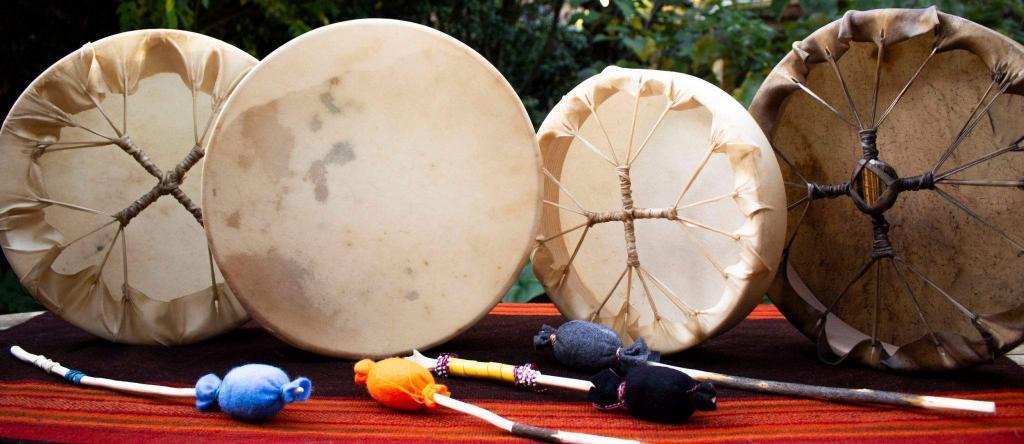Shamanic Drumming

By Michael L Drake
Estimated to be between 20,000 and 30,000 years old, shamanic drumming is considered one of the oldest methods for healing. Practiced in diverse cultures around the planet, this technique is strikingly similar the world over. Shamanic drumming uses a single, repetitive rhythm played at a tempo of three to four beats per second. Although sounding quite simple and redundant, the unique connection between the drum and the shaman gives this drumming great power, richness, and depth.
The sound of the drum is very important. It is the subtle variations in timbre and ever-changing overtones of the drum that allow the shaman to communicate with the spiritual realm. Part of the shaman’s training involves learning to hear and interpret a larger range of frequencies than the normal person can. The shaman listens and finds the right tone, the right sound to which the spirits will respond. Through the many tones, pitches, and harmonics of the drum, the shaman communes with the subtle and normally unseen energies of the spirit world.
Tuvan shamans believe that the spirits of nature create their own sound world, and it is possible for humans to communicate with them through the sound of the drum. Tuva (southern Siberia) is one of the few places in the world where the shamanic heritage has remained unbroken. Tuvan shamans use the drum to convey to the spirits of a place their greetings, any requests, and thanks. It is a spiritual practice designed to help human beings relate to all of nature.
Drumming opens the shaman’s inner, spiritual ears and eyes and also calls the helping spirits. As Tuvan musicologist Valentina Suzukei explains, “By changing and listening to the frequencies and overtones of the drum, the shaman is able to send messages to, and receive them from, both the spirit world and the patient. For example, the shaman might use the overtones to send signals to the sky, where they provoke a voice from the cosmos; in turn, the cosmic signals are caught on the drum and reflected to the shaman through the creation of subsequent overtones.”(n1) The shaman builds a sonic landscape which interacts with the natural world.
Functions of the Shamanic Drum
The primary cross-cultural function of shamanic drumming is to induce altered states of consciousness for both journey and embodiment trances. Shamanism is the intentional effort to acquire and nurture ongoing relationships with personal helping spirits by journeying into realms where the spirits dwell. The reason for developing personal relationships with spirit helpers is to gain wisdom, healing techniques, and other vital information that can benefit the community.
When a spirit is invoked, there is often an accompanying rhythm that evolves. Shamans frequently use specific rhythms to summon their helping spirits for the work at hand. Shamans may have a repertory of established healing rhythms to treat a variety of conditions, or improvise a new rhythm, uniquely indicated for the situation.
“From the shaman’s perspective, the drum is used to call on his or her helping spirits for entry into and support in the spirit world. The drumbeat also serves as an anchor, or lifeline, that the shaman follows to return to his or her body and/or the exit the trance state when the trance work is complete. The other specific uses of the drum are diverse and determined by culture. Each culture has its own pattern of rhythms that serve the different functions of ritual and ceremony.”(n2)
Drumming Promotes Healing
Like the colors of the rainbow, each culture has its own hue or identity, yet each is a part of the whole. Although the function or intent may differ from culture to culture, rhythmic drumming invariably has the same power and therapeutic effects in all traditions. The resonant qualities and attributes of these rhythmic phenomena are universal and come into play whenever we drum. The sound waves produced by the drum impart their energy to the resonating systems of the body, mind, and spirit, making them vibrate in sympathy. When we drum, our living flesh, brainwaves, and spiritual energy patterns begin to vibrate in response.
Science is now verifying the therapeutic effects of drumming. Recent medical research studies indicate that drumming boosts the immune system and produces natural pleasurable experiences, enhanced awareness of preconscious dynamics, a release of emotional trauma, and reintegration of self. Other studies have demonstrated the calming, focusing, and healing effects of drumming on Alzheimer’s patients, autistic children, emotionally disturbed teens, substance abusers, trauma patients, and prison and homeless populations. Study results demonstrate that drumming is a valuable treatment for stress, fatigue, anxiety, hypertension, headaches, asthma, chronic pain, arthritis, and sleep and emotional disorders.
References:
(n1) Kira Van Deusen, “Shamanism and Music in Tuva and Khakassia,” Shaman’s Drum, No. 47, Winter 1997, p. 24.
(n2) Christina Pratt, An Encyclopedia of Shamanism (The Rosen Publishing Group, 2007), p. 151
Copyright 2008 by Michael Drake


